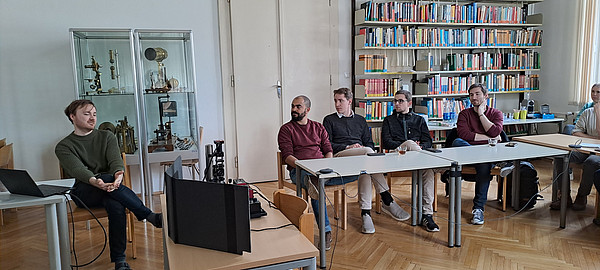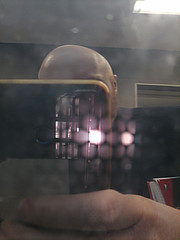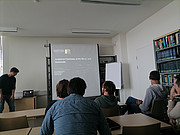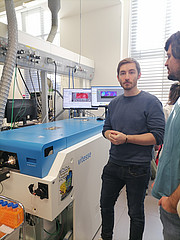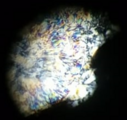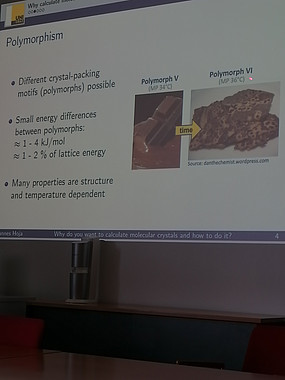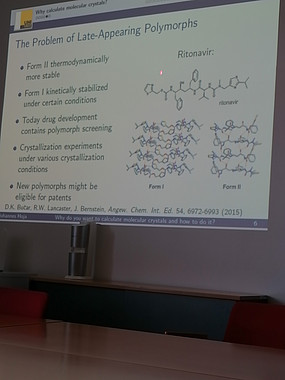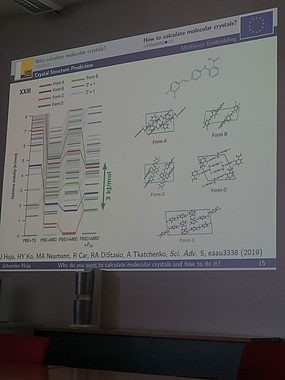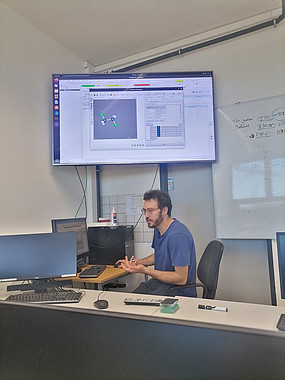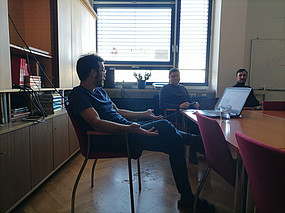Veranstaltungen
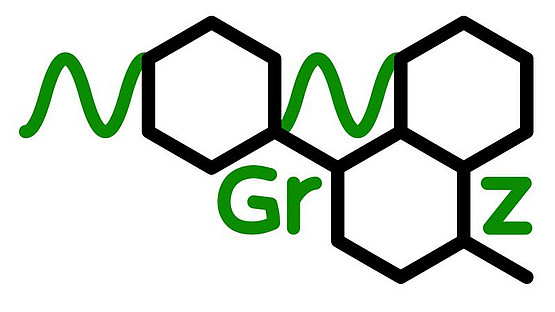
The NANO GRAZ group convened at BRAVE Analytics, a startup located on the Medical University Graz campus, to explore innovative nanoparticle characterization technologies. The focal point of the meeting was the demonstration of OF2i® (Opto Fluidic Force Induction) [1], a technology developed by BRAVE Analytics that offers real-time, online particle size distribution (PSD) analysis in liquid samples. This method excels at managing highly polydisperse samples and is ideal for monitoring nanoparticle-based product manufacturing processes in real time [2].
In addition to OF2i®, BRAVE Analytics is advancing a RAMAN module [3] designed to extract composition-related information from samples. This development promises to enhance the analytical capabilities of the OF2i® technology further.
Separately, Raphael Hauer, a PhD student under Prof. Dr. Ulrich Hohenester, is working on a Large Particle Count (LPC) module. This module specifically targets the large particle tail of typical PSDs, focusing on particles in the low to medium μm range, providing a critical enhancement to the current particle characterization toolkit.
The session included a comprehensive introduction to the company’s history, detailed explanations of the technologies mentioned, and was concluded with a guided tour through the laboratories. During the tour, Karin Griessmair led a hands-on demonstration, showcasing the practical application of the OF2i® technology.
[1] M. Šimić, et al., Phys. Rev. Appl., 18, 024056 (2022)
[2] M. Šimić, et al., Anal. And Bioanal. Chem., 415, 5181-5191
[3] C. Neuper, et al., ChemRxiv. 2023; doi: 10.26434/chemrxiv-2023-hwgll
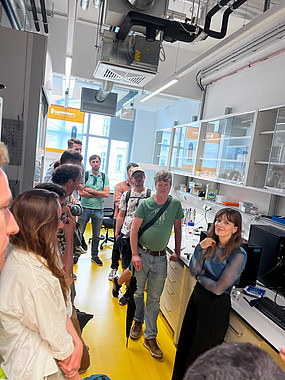
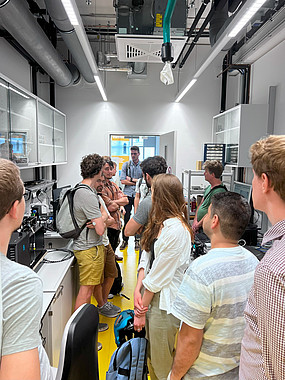
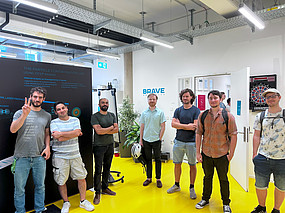
On April 25, 2024, Laura Wiltschko from the research group led by Prof. Eva Roblegg organized the monthly meeting of the Doctoral Academy NanoGraz. The meeting took place in the library of the Institute of Pharmaceutical Technology and Biopharmacy. Three concise presentations were delivered by PhD candidates, offering insights into ongoing research topics.
After introducing the group members, Laura Wiltschko provided a comprehensive overview of one major sampling method for interstitial fluid, which is utilized in her thesis, namely open flow microperfusion. Following this, Christina Glader presented a segment of her research focusing on real-time quality assurance in continuous nanoparticle manufacturing. Subsequently, Bianca Brandl gave an overview of novel biodegradable subcutaneous implants manufactured via high-resolution 3D printing. Afterwards, a brief laboratory tour was held through the laboratories of pharmaceutical technology. Bianca Brandl showed an ongoing release study of her subcutaneous implants using Sotax and Laura Wiltschko presented a dermal open flow microperfusion setup, where tissue concentrations of a topical formulation were determined in ex vivo human skin.
We hope that sharing our research insights will enrich our interdisciplinary discussions and lead to new future collaborations.
Seminar "Physical and Theoretical Chemistry"
In2O3(111): Surface Structure and Adsorption of Small Molecules
Margareta Wagner
Institute of Applied Physics, TU Wien
Indium oxide, a transparent conductive oxide (TCO), is widely used in semiconductor industry but it also displays promising performance in electro- and photo catalytic reactions. As the interface is central in all these applications, understanding the fundamental properties is critical, especially when going to nanoscopic dimensions in novel device architectures.
As a model system we investigate the non-polar In2O3(111) surface[1] experimentally with low temperature scanning tunnelling microscopy and atomic force microscopy (STM, AFM), temperature programmed desorption (TPD) and x-ray photoelectron spectroscopy (XPS), and with density functional theory (DFT) calculations. This talk gives an overview on our current investigations on In2O3(111) including the adsorption of water and the interaction with small organic molecules.
In2O3(111) has an intrinsically large unit cell composed of a hydrophilic and a hydrophobic area. We test the reactivity of these areas by unravelling the interfacial water structures for the whole range of water coverages in UHV, from single dissociated molecules[2,3] to multilayers. Even at high coverages we clearly see hydrophilicity and hydrophobicity within the unit cell, both in experiments and calculations[4]. Comparison with methanol and acetylene shows common adsorption preferences.
The interaction of conjugated organic molecules with surfaces is of great fundamental interest and important in many applied areas. Surface science investigations have significantly contributed to understand the organics/metal interface, but the second electrode in such devices – the one that is optically transparent – is unknown territory. Our studies aim at closing this gap: Starting with the smallest aromatic molecule, benzene, we expand to more complex organic molecules including phthalocyanines and study the interaction with the In2O3(111) surface and the condensation into 2dim structures.
[1] M. Wagner, et al. Reducing the In2O3(111) Surface Results in Ordered Indium Adatoms. Adv. Mater. Interfaces 1, 1400289 (2014).
[2] M. Wagner, et al. Direct assessment of the acidity of individual surface hydroxyls. Nature 592, 722–725 (2021).
[3] M. Wagner, et al. Resolving the Structure of a Well-ordered Hydroxyl Overlayer on In2O3(111): Nanomanipulation and Theory. ACS Nano 11, 11531–11541 (2017).
[4] H. Chen et al. A locally hydrophobic oxide surface: In2O3(111). ACS Nano, 16, 12, 21163–21173 (2022).
Friday, 03 May 2024, 2.00 pm
Lecture hall HS 10.01, Heinrichstraße 28, ground floor
The meeting concentrated on the practical aspects of numerical modeling for systems with axial symmetry using COMSOL Multiphysics. A single particle was employed as a model to investigate methods for calculating optical forces and the scattering cross-section of a plane electromagnetic wave in such systems. Furthermore, the concept of multipole decomposition and the techniques for performing these calculations were discussed. The meeting was organized by Sergei Gladyshev, a member of Professor Thomas Weiss's research group.
Seminar "Physical and Theoretical Chemistry"
Harnessing Coulombic Interactions to Prepare High-Quality Colloidal Crystals
Rafal Klajn
IST Austria
Self-assembly of inorganic nanoparticles (NPs) into ordered structures (“superlattices”) has led to a wide range of nanomaterials with unique optical, electronic, and catalytic properties. Various interactions have been employed to direct the crystallization of NPs, including van der Waals forces, hydrogen bonding, as well as electric and magnetic dipolar interactions [1]. Among them, Coulombic interactions have remained largely unexplored, owing to the rapid charge ligand exchange between NPs bearing high densities of opposite charges. In this talk, I will describe a new method [2] to assemble these “superionic NPs” under conditions that preserve their native surface charge density. Our methodology was used to assemble oppositely charged NPs into high-quality superlattices exhibiting Catalan shapes [3]. The methodology can be applied to a wide range of charged nanoparticles of various sizes, shapes, and compositions. I will also discuss different ways to employ electrostatic interactions to assemble NPs into transient assemblies [2,4], whose lifetimes depend on and can be controlled by the availability of small-molecule ionic “fuels”.
[1] M. A. Boles, M. Engel, D. V. Talapin, Chem. Rev. 2016, 116, 11220–11289.
[2] T. Bian et al., Nat. Chem. 2021, 13, 940–949.
[3] T. Bian et al. ChemRxiv 2022 10.26434/chemrxiv-2022-klncg.
[4] J. Wang, T. S. Peled, R. Klajn, J. Am. Chem. Soc., 2023, 145, 4098–4108.
Friday, 8 March 2024, 2.00 pm
Lecture hall HS 10.01, Heinrichstraße 28, EG
We conducted our first monthly meeting of the Doctoral Academy NanoGraz on the 25th of January at the Institute of Chemistry (Analytical Chemistry) at the KFU Graz, where our newest member Prof. David Clases gave an introduction into his group’s research, which is centered around particles with dimensions at the micro- and nanoscale (NanoMicroLab). Nanoparticles measure between 1 – 100 nm diameter in at least one dimension of space and often exhibit unique physical and chemical properties, which are not observed for their bulk analogues. These properties depend on size, composition and number concentrations and analytical techniques to determine these parameters are in high demand. However, also larger particles and structures can be found ubiquitously in the environment and in biological systems and we require new perspectives to study and understand them.
In a short presentation, Prof. Clases and his group provided an overview on the facets of inductively coupled plasma-mass spectrometry (ICP-MS) to study and to describe relevant characteristics of individual nanoparticles (Single Particle ICP-MS) as well as to map elemental distribution in microstructures (LA-ICP-MS) quantitatively. In a lab-tour, two of the most modern element mass spectrometers and a laser ablation system were prepared and demonstrated to recover, map, and quantify TiO2 nanoparticles in biological tissues.
Seminar "Physical and Theoretical Chemistry"
Exploring Pharmaceutical Cocrystals: Bridging Theory and Experiment
Doris E. Braun
Institute of Pharmacy, University of Innsbruck, Austria
An essential step in the development of drug products is the control of the physical properties of solid forms for active pharmaceutical ingredients (APIs). The use of multi-component phase systems, such as cocrystals, allows to modify and improve critical physicochemical properties of APIs, i.e. chemical/physical stability and solubility [1,2]. However, it is challenging to predict in advance which coformers will form cocrystals with a specific compound. Moreover, cocrystals can exist in different ratios of coformers, exhibit various packing arrangements with the same composition (polymorphism), and may include a solvent (solvates) or water (hydrates). Several computational [3,4] and experimental techniques [5] have been developed to estimate cocrystal formation and synthesize cocrystals, respectively. However, there is limited consistency in the application of the proposed experimental protocols, resulting in the current state-of-the-art cocrystal discovery being a time-consuming process. This talk aims at providing new insights into cocrystal screening and the solid form landscapes of coccrystals of model pharmaceuticals.
Metronidazole cocrystals were employed for evaluating commonly used virtual cocrystal screening methods, including assessments of molecular complementarity, multi-component hydrogen bond propensity, and molecular electrostatic potentials. This allowed for the identification of both the strengths and limitations inherent in the readily available virtual tools [6]. Carbamazepine, acetylsalicylic acid, and acetaminophen were selected as test compounds to assess crystal structure prediction (CSP) for cocrystal screening against a range of potential coformers, to ascertain the most stable cocrystal form, and to evaluate the feasibility of cocrystallization [4]. The cocrystal landscapes of dapsone with three coformers (2,2’-bipyridine, 4,4’-bipyridine, and flavone) were systematically elucidated using state-of-the-art experimental and computational approaches. The combined experimental and computational screening led to the discovery of novel multicomponent solid-state forms and provided insights into the stability order [7].
Overall, the significance of employing a combination of computational and analytical techniques to gain a deeper understanding of cocrystal formation and cocrystal stability will be discussed, allowing finally to assess the potential of specific cocrystals for the use in pharmaceutical products.
References
[1] Kavanagh, O. N.; Croker, D. M.; Walker, G. M. & Zaworotko, M. J. (2019). Drug Discov. Today 24, 796-804. [2] Kuminek, G.; Cao, F.; Bahia de Oliveira da Rocha, A.; Goncalves Cardoso, S.; Rodriguez-Hornedo, N. (2016). Adv. Drug Deliv. Rev. 101, 143-166. [3] Kumar, A. & Nanda, A. (2021). J. Drug Deliv. Sci. Technol. 63, 102527. [4] Sugden, I. J.; Braun, D. E.; Bowskill, D. H.; Adjiman, C. S. & Pantelides, C. C. (2022). Cryst. Growth Des. 22, 451-4527. [5] Rodrigues, M.; Baptista, B.; Lopes; J. A. & Sarraguca, M. C. (2018). Int. J. Pharm. 547, 404-420. [6] Dyba, A. J.; Wiącek, E.; Nowak, N.; Janczak, J.; Nartowski, K. P.; Braun, D. E. (2023). Cryst. Growth Des. 23, 8241–8260. [7] Racher, F.; Petrick, T. L.; Braun, D. E. (2023). Cryst. Growth Des. 23, 4638–4651.
Freitag, 26. Jänner 2024, 14.00 Uhr
Hörsaal HS 10.01, Heinrichstraße 28, EG
Seminar "Physical and Theoretical Chemistry"
Optics meets STM: Exploring ultrafast dynamics and light-matter interaction at atomic scales
Melanie Müller
Fritz Haber Institute of the Max Planck Society, Faradayweg 4-6, 14195 Berlin, Germany
In this talk I will introduce light-driven scanning tunneling microscopy (STM) and demonstrate its potential to probe ultrafast electronic and structural excitations and nonequilibrium processes at solid surfaces and in atomic-scale tunnel junctions. First, I will introduce different approaches to classify whether quantum, photon-driven or classical, field-driven tunneling dominates light-matter interaction in STM [1]. I will present our work on photoinduced tunneling processes and address the question whether thermal and/or nonthermal electron tunneling dominates in optically excited metallic STM junctions [2,3]. I will further demonstrate that photon-driven tunneling allows to map coherent lattice vibrations in ultrathin ZnO/Ag(111) with ~1 nm spatial resolution [4], providing complementary information to steady-state vibrational local probes such as tip-enhanced Raman spectroscopy (TERS). Moreover, I will present first results on THz-lightwave-driven STM (THz-STM) and demonstrate ultrafast detection of the coherent amplitude mode (AM) of the charge density wave (CDW) in 1T-TaS2 [4]. I will discuss possible mechanisms by which the rectified tunneling current in THz-STM can be modulated by the coherent AM, and that coherent oscillation of the local charge density dominates over gap size modulation due to coherent atomic motion. Finally, I will outline future directions for imaging the spatiotemporal evolution of macroscopic quantum states in strongly correlated materials by USTM.
[1] Müller, Prog. Surf. Sci., in press: doi.org/10.1016/j.progsurf.2023.100727 (2023)
[2] Martín-Sabanés et al., ACS Nano 16, 9 (2022)
[3] Lin et al., ACS Photonics10, 10, 3637–3646 (2023)
[4] Liu et al., Sci. Adv. abq5682 (2022)
[5] L. E. Parra Lopéz et al., in preparation
Freitag, 19. Jänner 2024, 14.00 Uhr
Hörsaal HS 10.01, Heinrichstraße 28, EG
Seminar "Physical and Theoretical Chemistry"
A systematic framework for crystal structure prediction: Development and application to product design
Claire S. Adjiman and Constantinos C. Pantelides
Imperial College London
Organic molecules can often crystallise in more than one structure, giving rise to polymorphs that exhibit significant differences in their properties (e.g., melting point, solubility, colour, density). Knowledge of the structures that are likely to be observed is of critical importance in the development of new products in many industries, including the pharmaceutical and agrochemical industries. This can be achieved via experimental polymorph screens but these require both time and material, two resources that are often scarce during development. It is thus desirable to complement polymorph screens with in silico crystal structure prediction (CSP).
In this talk, we present a hierarchical methodology for CSP that has been successfully applied to several organic molecules. We discuss how to balance accuracy and computational cost by building surrogate models from quantum mechanical data and conducting increasingly focussed structure searches based on more accurate (and expensive) models. We discuss several applications of this approach in the context of CSP and show how it can be used to support product design activities, such as investigating crystallisability or identifying coformers to achieve more stable crystal structures.
Freitag, 15. Dezember 2023, 14.00 Uhr
Hörsaal HS 10.01, Heinrichstraße 28, EG
Electron Donor-Acceptor Complexes
Andreas Opitz
Institut für Physik, Supramolekulare Systeme HUMBOLDT-UNIVERSITÄT zu BERLIN
Electron donating and electron accepting molecular materials are used in a wide range of applications, e.g. for charge separation in organic solar cells, for charge recombination in organic light emitting diodes and for increase of free charge carriers by molecular doping. These materials are able to form adduct without covalent bonds the electron donor-acceptor complexes, also called charge-transfer complexes. In this talk I will present insights into electron donor-acceptor complexes from history, own research and literature. The distinction between these complexes and exciplexes will be clarified and examples of molecular and polymeric complexes will be shown. Even if the research on electron donor-acceptor complexes started more than 70 years ago it is still a fruitful and exciting field in materials science.
Freitag, 1. Dezember 2023, 14.00 Uhr
Hörsaal HS 10.01, Heinrichstraße 28, EG
Das letzte monatliche NanoGraz Meeting fand am 25. Oktober 2023 am IMB in der Abteilung für Biophysik mit insgesamt 12 Teilnehmern, einschließlich des Organisators, statt. Die Leitung dieses Meetings lag in meinen Händen. Mein Supervisor Georg Pabst sowie meine Kollegen James Jennings und Michael Kaltenegger waren aktiv an der Gestaltung des Meetings beteiligt.
Die Veranstaltung gliederte sich in zwei Teile: die Vorstellung der laufenden Forschungsprojekte und eine Führung durch das Labor. Die einführende Präsentation bot einen Überblick über die Forschungstätigkeiten innerhalb der Pabst-Gruppe und behandelte verschiedene Aspekte der Struktur und Funktion biologischer Membranen. Drei spezifische Forschungsprojekte wurden vorgestellt: „Effect of Membrane Asymmetry on Protein Activity“, „Membrane Curvature Stress Mediated Self-Association of Proteins“ und „Cationic Lipidoids: Liquid Crystalline Self-Assembly and Membrane-Targeting Antimicrobial Activity“.
Im Anschluss an die Präsentation folgte eine Laborführung, bei der verschiedene Laborgeräte wie beispielsweise DLS oder DSC, sowie Mikroskopiebilder von Lipidoiden gezeigt wurden. Besonderes Augenmerk wurde auf die Präparation asymmetrischer Vesikel gelegt, für die das Pabst Lab bekannt ist. Der letzte thematische Schwerpunkt der Führung lag auf der Röntgen-Kleinwinkelstreuung. Hier wurden die örtliche SAXS-Labor-Beamline (SAXSpoint 5.0) erläutert und typische Streubilder von Lipidproben präsentiert.
Das Meeting schloss mit fruchtbaren Diskussionen ab, und das Feedback im Anschluss war äußerst positiv.
Anharmonic Effects in Heat and Charge Transport: Fundamental Concepts, Novel Methods, and Relevant Applications
Christian Carbogno
Theory Department, Fritz Haber Institute Berlin
Although the quintessential role of anharmonicity for vibrational thermal conductivities, κ, is long known, a theory that quantitatively links κ to strongly anharmonic phenomena such as defect formation, phase transitions, and their precursors is still missing. We overcome this hurdle using symbolic regression and sensitivity analysis, thereby identifying the fundamental actuating mechanisms. This allows us to devise a rapid high-throughput workflow for thermal insulator discovery, which we demonstrate by scanning over 700 materials and identifying 80 ultra-insulating compounds [1]. The underlying microscopic mechanisms are investigated by fully anharmonic ab initio Green-Kubo calculations for over 50 materials [2], which substantiate that short-lived symmetry changes, e.g., local distortions or global rearrangements, lead to a breakdown of the phonon picture and to ultra-low κ. Eventually, we discuss how to account for these phenomena when assessing electronic transport properties [3].
[1] T. A. R. Purcell, M. Scheffler, L. M. Ghiringhelli, and C. Carbogno, Npj Comput. Mater. 9, 112 (2023).
[2] F. Knoop, T. A. R. Purcell, M. Scheffler, and C. Carbogno, Phys. Rev. Lett. 130, 236301 (2023).
[3] M. Zacharias, M. Scheffler, and C. Carbogno, Phys. Rev. B 102, 045126 (2020).
Freitag, 20. Oktober 2023, 14.00 Uhr
Hörsaal HS 10.01, Heinrichstraße 28, EG
Molecular Nanoprobe – utilizing a single molecule as detector
Markus Leisegang
Faculty of Physics, Experimental Physics 2, University of Würzburg Understanding the propagation of charge carriers at the nanometer scale is of great interest for optimizing electronic circuits, but its investigation still remains a challenging task. In order to get real space access to charge carrier transport at distances of the mean free path and thus in the ballistic regime, we invented the molecular nanoprobe (MONA). I will present this technique, where a single molecule serves as a detector for charge carriers injected remotely by an STM tip. We have performed measurements on various substrates, revealing the transport in surface states, interference and scattering of charge carriers on atomic structures and, most recently, spin-momentum locked transport of spinpolarized charge carriers. Given the important role of the molecule as a detector, I will discuss the required properties and our results for different molecular switches in the context of our MONA experiments.
Freitag, 06. Oktober 2023, 14.00 Uhr
Hörsaal HS 10.01, Heinrichstraße 28, EG
The monthly meeting of the Doctoral Academy Nano Graz was held on the 22nd of June at the Research Center Pharmaceutical Engineering (RCPE). The meeting was hosted by the research group of Prof. Eva Roblegg, whose research focuses on "Drug delivery and advanced manufacturing". Christina Glader (PhD candidate) organized the meeting, introduced the group members and gave an overview of the general research topics. She then presented her research project, which focuses on the continuous manufacturing of lipid nanoparticles using scalable microfluidization technology under continuous process control and monitoring of product quality. This was followed by Scarlett Zeiringer's (PhD candidate), who is working on in vitro cell culture systems to mimic human biological barriers to study interactions with, for example, nano drug delivery systems. Laura Wiltschko (PhD candidate) gave an overview of the use of open-flow microperfusion to detect and quantify free and bound drug concentrations in skin and buccal tissue. Finally, Simone Eder (Principal Scientist), replacing Bianca Brandl (PhD candidate), presented the use of 3D printing for the production of personalized subcutaneous implants as drug delivery systems. To give a better insight into the practical work, the members of the NanoGraz Doctoral Academy had the opportunity to visit the Nano Lab and the pilot plant at the RCPE in a subsequent lab tour.
We hope that by presenting the activities of the working group, fruitful future collaborations can be established. The interdisciplinary discussions that took place following the presentations and during the laboratory tour have already created an important basis for this.
Minimally Empirical Double-Hybrid Density Functional Theory: G4-level accuracy at DFT+ cost
Golokesh Santra,a,b Emmanouil Semidalas,a Nisha Mehta, a and Jan M. L. Martina
a Department of Molecular Chemistry and Materials Science, Weizmann Institute of Science. 7610001 Reḥovot, Israel
b Present address: Max Planckinstitut für Kohlenforschung, Mülheim, Germany
Contact: gershom@weizmann.ac.il
We have shown[1,2] that, for large and chemically diverse benchmark suites like GMTKN55 [3], double hybrid density functional theory can reach performance levels historically associated with composite wavefunction theory methods like G4 theory, and that it can do so with only a modicum of empiricism. Despite not being parametrized for vibrational frequencies at all, it predicts harmonic frequencies with RMSD=10 cm-1, compared to 5 cm-1 for CCSD(T) and over 30 cm-1 for MP2 and hybrid DFT.
Somewhat to our surprise, we found[4,5] no major further benefits from range separation or to replacing PT2 correlation with dRPA, although the latter removed virtually all sensitivity to the underlying semilocal exchange-correlation functional. Using an additional third-order correction in a basis of Kohn-Sham orbitals does help matters further: With this so-called XYG9 functional, we were able [6] to bring down WTMAD2 (weighted mean absolute deviation) over GMTKN5 to just 1.17 kcal/mol, comparable to the best composite wavefunction schemes. If a slightly higher WTMAD2=1.42 is acceptable, both dispersion correction and post-LDA corrections in the underlying orbitals can be eliminated.
In an attempt to address the slower basis set convergence of double hybrids, we have considered evaluating the PT2 contribution by F12 explicitly correlated approaches, and additionally to use localized pair natural orbital (LPNO) approximations to reduce CPU time scaling with system size. We found [7,8] that even the small cc-pVDZ-F12 basis set is as close to the basis set limit as cc-pV5Z in a conventional double hybrid, and that the LPNO approximation does not significantly reduce accuracy.
Time permitting, we will also discuss some recent findings[9] about the benefits of lambda-coupled cluster theory[10] for high-accuracy thermochemistry.
References
- G. Santra, N. Sylvetsky, J. M. L. Martin, Journal of Physical Chemistry A 123, 5129-5143 (2019).
- J. M. L. Martin, G. Santra, Israel Journal of Chemistry 60, 787-804 (2020).
- L. Goerigk et al., PCCP 19, 32184–32215 (2017).
- G. Santra, M.Cho, J. M. L. Martin, J. Phys. Chem. A 125, 4614-4627 (2021).
- G. Santra, E. Semidalas, J. M. L. Martin, J. Phys. Chem. A 125, 4628-4637 (2021).
- G. Santra, E. Semidalas, J. M. L. Martin, J. Phys. Chem. Lett. 12, 9368-9376 (2021).
- N. Mehta, J. M. L. Martin, Journal of Chemical Theory and Computation 18, 5978-5991 (2022).
- N. Mehta, J. M. L. Martin, Journal of Physical Chemistry Letters 13, 9332-9338 (2022).
- M. Spiegel, E. Semidalas, J. M. L. Martin, M. R. Bentley, J. F. Stanton, to be published.
- J. F. Stanton, J. Gauss, Theoretica Chimica Acta 93, 303-313 (1996).
Freitag, 07. Juli 2023, 14.00 Uhr
Hörsaal HS 10.01, Heinrichstraße 28, EG
Interfacial Premelting in Ice/Clay Nanocomposites
Markus Mezger
Fakultät für Physik, Universität Wien
At solid/ice interfaces, a premelting layer is formed at temperatures below the melting point of bulk water. This interfacial premelting layer in ice/clay nano composites was studied by quasi elastic neutron scattering and high energy X-ray diffraction. Using well defined and characterized ice/vermiculite, ice/kaolin, and ice/talc composite samples, this work bridges the gap between studies on single crystalline ice/solid model interfaces and naturally occurring soils and permafrost.
Below the melting point of bulk water, the formation of liquid water was observed. The liquid fraction is gradually increasing with temperature. Quantitative analysis of the molten fraction reveals differences in the deviation from Antonow’s rule relating the interfacial free energy between ice, water, and the clays. The translational diffusion constants of the confined premelting water is strongly reduced compared to super cooled bulk water. Adjacent to charged vermiculite the lowest water mobility was observed, followed by kaolin and the more hydrophobic talc. Results are explained by the intermolecular water interactions with different clay surfaces and interfacial segregation of the low-density liquid water (LDL) component.
References:
H. Li, M. Bier, J. Mars, H. Weiss, A.-C. Dippel, O. Gutowski, V. Honkimäki, and M. Mezger, Phys. Chem. Chem. Phys. 21, 3734 (2019).
H. Li, J. Mars, W. Lohstroh, M.M. Koza, H.-J. Butt, and M. Mezger, Angew. Chem. Int. Ed. 60, 7697 (2021).
Freitag, 16. Juni 2023, 14.00 Uhr
Hörsaal HS 10.01, Heinrichstraße 28, EG
Graz Advanced School of Science
PHYSICS COLLOQUIUM OF THE UNIVERSITY OF GRAZ AND THE GRAZ UNIVERSITY OF TECHNOLOGY
Dr. Mario Hentschel
University of Stuttgart
Dielectric Mie voids
Manipulating light on the nanoscale has become a central challenge in metadevices, resonant surfaces, nanoscale optical sensors and many more, and it is largely based on resonant light confinement in dispersive and lossy metals and dielectrics. I will discuss a novel paradigm in dielectric nanophotonics, the resonant subwavelength confinement of light in air. Voids created in dielectric host materials support localized resonant modes with exceptional optical properties. Due to the confinement in air, the modes do not suffer from loss and dispersion of dielectric host media and even allow resonant confinement of UV light. Interestingly, these structures can be viewed as “Mie voids”, described Mie’s original theory. We experimentally realize these resonant Mie voids by focused ion beam milling into bulk silicon wafers and experimentally demonstrate resonant light confinement down to the UV spectral range at 265 nm (4.68 eV). Furthermore, we utilize the bright, intense, and naturalistic colours for nanoscale colour printing. Mie voids will thus push the operation of functional high-index metasurfaces into the blue and UV spectral range. Moreover, this extension will enable novel antenna and structure designs which benefit from the full access to the modal field inside the void as well as the nearly free choice of the high-index material for novel sensing and active manipulation strategies.
Time: Tuesday 6th June 2023
Lecture: 4:15 p.m. until 5:15 p.m. HS 05.01, ground floor
Meet the speaker: 3:45 p.m. until 4:15 p.m., Library Experimental Physics, 1st floor
Address: Universitätsplatz 5, 8010 Graz
Host: Thomas Weiss
Excited States of Transition-Metal Complexes with Multi-Reference Linear Response Methods
Benjamin Helmich-Paris
Max-Planck-Institut für Kohlenforschung, Mülheim an der Ruhr, Germany
These days, calculations of excited states of open-shell molecules such as transition-metal complexes (TMC) are still a challenge for quantum chemical methods. For those systems, the competition of many sizable configurations in the wavefunction expansion requires the usage of multi-reference (MR) methods even when investigating the ground state only. The active-space orbitals from which all reference configurations are generated is still limited to 14-18 orbitals as it results in billions of configurations and keeps on growing exponentially. In practice, this is a severe limitation for excited-state calculations of TMC, in particular, with larger organic pi ligands.
In this talk, I will elaborate on MR linear-response (LR) approaches that are capable of describing both excitations within the active orbitals but additionally excitations involving core and virtual – non-active space orbitals.[1] So far, LR methods were not capable of describing excitations from (quasi-)degenerate open-shell ground states. To resolve this limitation, the LR formalism is applied to state-averaged CASSCF solutions for an ensemble of ground states, which has been recently developed in my group.
For small molecules and large active spaces, as in case of the permanganate ion, CASSCF-LR gives very good agreement with experiment and other formally more accurate wavefunction methods. Calculations on large TMC with minimal-active spaces, including only valence d orbitals, are feasible with CASSCF-LR, though, often give poor results in particular for charge-transfer CT excitations. CT excitations are often accompanied by large differential dynamic correlation. Current projects in my group to include dynamic correlation are outlined and their prospect is discussed.
[1] B. Helmich-Paris, J. Chem. Phys. 150, 174121 (2019)
Freitag, 02. Juni 2023, 14.00 Uhr
Hörsaal HS 10.01, Heinrichstraße 28, EG
Nanoskopische Einblicke in die Funktion von Zellmembranen
Georg Pabst
Biophysik, Institut für Molekulare Biowissenschaften, Universität Graz
Biologische Membranen sind faszinierende multifunktionale Schnittstellen in und um Zellen. Transport, Kommunikation oder diverse katalytische Prozesse sind Beispiele für die vielfältigen Aufgaben von biologischen Membranen, die allesamt eng mit den Eigenschaften dieser nur etwa fünf Nanometer dicken Schicht verknüpft sind. Wie viel Physik steckt in Zellmembranen? Wie gelingen in diesem dynamischen Zusammenspiel abertausender Moleküle physikalische Einblicke, und kann man damit neue Medikamente entwickeln?
Wir laden herzlich zu einem Vortrag aus einem Forschungsbereich zwischen Physik, Biologie, Chemie und Medizin.
Mittwoch, 24. Mai 2023, 17 Uhr
HS 05.12, Institut für Physik, Universitätsplatz 5, 1. Stock
https://physik.uni-graz.at/de/facetten/
Graz Advanced School of Science
PHYSICS COLLOQUIUM OF THE UNIVERSITY OF GRAZ AND THE GRAZ UNIVERSITY OF TECHNOLOGY
Kareem Elsayad
Advanced Microscopy, Vienna Biocenter Core Facilities
Feeling Life with Light
The colour of light scattered from an object can give us information on its chemical consistency. For
example, a moldy apple will be a different colour to a fresh one. If we analyze the spectrum of colours
even more carefully and under special illumination conditions we can even identify individual chemical
constituents and their abundance. Less well known though is that it can also tell us about the objects'
mechanical properties - namely, how elastic and viscous it is. To do so however requires more
elaborate instruments for measuring the scattered lights' spectrum. I will talk about this, explaining
the principles of the scattering processes involved, and what they can and can't tell us. I will then go
on to describe some experiments in my lab, and how we have used this to understand how plant cells
grow to take on the shapes that they do, as a means for diagnosing the severity of COVID and
potentially long-COVID from blood plasma, and to uncover a hidden dynamic structure in the cell
nucleus that appears to coordinate genetic transcription.
Date: Tuesday, 16 May, 16:15
Location: Lecture Hall P2, Petersgasse 16, Graz University of Technology
Host: P. Banzer und M. Schultze
For a regularly updated colloquium program see: www.if.tugraz.at/colloquium.html
Tuneable Catalysts for Energy Conversion
C. Rameshan
Chair of Physical Chemistry, Montanuniversität Leoben
Perovskite oxides with their general structure ABO3 are an extremely versatile material class. They are stable at high temperatures even under harsh environments. Both A- and B-site of the host lattice can be doped, enabling a materials design approach (e.g., for utilization as electrode material, solar cell, catalyst or gas sensor). For our particular materials, their catalytic properties are optimized for catalytic and electrocatalytic energy conversion applications. Additionally, perovskite oxides can exsolve B-site cations under reducing conditions (i.e. the growth of finely dispersed nanoparticle on the surface). This feature makes them particularly interesting as novel catalyst materials for high temperature reactions.
In our work we highlight how we can tune the composition of different perovskites to optimize their surface and bulk properties. By a combination of spectroscopic (in-situ) characterization with theoretical calculations we can understand their specific properties. Especially the rich oxygen surface chemistry of these novel materials is responsible for the activation of CO2 and its further transformation in valuable products. Furthermore, perovskites can prevent some of the major problems of catalyst deactivation. The sintering of active nanoparticles and the deactivation by coke formation.
Freitag, 12. Mai 2023, 14.00 Uhr
Hörsaal HS 10.01, Heinrichstraße 28, EG
Investigating Interfacial Water Dynamics using Machine Learned Electron Densities
Alan Lewis
MPI Hamburg
Sum Frequency Generation (SFG) spectroscopy is a powerful experimental technique that can selectively probe the vibrational modes at water interfaces. However, interpreting SFG spectra often requires computationally expensive simulations, without which experimental results can be difficult to assign and understand. I introduce a new approach to calculating the interfacial dipole moments and polarizabilities needed to simulate the SFG spectrum, avoiding the need for a molecular decomposition of these properties and in principle enabling the simulation of water/solid interfaces. These calculations can be dramatically accelerated using our newly developed machine learning methods, which predict the electron density and the response of the electron density to a homogeneous field, avoiding the need for costly density functional theory and density functional perturbation theory calculations. This allows us to simulate the extremely long molecular dynamics trajectories required to converge SFG spectra, while including all contributions and correlations in the response of the interface.
Freitag, 05. Mai 2023, 14.00 Uhr
Hörsaal HS 10.01, Heinrichstraße 28, EG
Simulation of light at the nanoscale
Ulrich Hohenester
Institut of Physics, Karl-Franzens University Graz
Nano optics deals with light confinement at the nanoscale [1]. This is achieved by binding light to coherent surface excitations of nanostructures, these are surface plasmon polaritons for metallic nanostructures and surface phonon polaritons for ionic nanostructures. These resonances come along with strongly localized fields and allow squeezing light into extreme subwavelength volumes, which can be exploited for various applications such as sensing, surface enhanced Raman scattering (SERS), or metasurfaces.
In this talk I will give an introduction to the basic principles underlying nano optics and will discuss our simulation approach for light at the nanoscale, based on a boundary element method (BEM) approach, which has been successfully employed for the simulation of various experiments. In electron energy loss spectroscopy (EELS), we have visualized the three-dimensional photonic environment in an electron microscope [2]. In optofluidic force induction (OF2i), optical forces are employed for trapping and acceleration of nanoparticles in a microfluidic channel, which allows for an optical nanoparticle characterization scheme that achieves real-time optical counting with single-particle sensitivity and high throughput [3].
[1] U. Hohenester, Nano and Quantum Optics (Springer, Cham, 2020).
[2] M. Lagos et al., Nature 543, 533 (2017); X. Li et al., Science 371, 1364 (2021).
[3] M. Šimić et al., Phys. Rev. Appl. 18, 024056 (2022) ; ibid 19, 034041 (2023).
Freitag, 28. April 2023, 14.00 Uhr
Hörsaal HS 10.01, Heinrichstraße 28, EG
In March's NanoGraz meeting the doctoral candidates paid a visit to the Quantum Chemistry group of Prof. Adrian Daniel Boese. They were given an overview on what computational and theoretical chemistry is all about by Johannes Hoja (Senior Scientist) and Peter Hartmann (PhD candidate, organizer), as well as the specific research topics of the research group.
Fields such as the development of density functionals, inverse density functional theory and symmetry adapted perturbation theory were briefly presented, moving on to the challenging subject of crystal structure prediction (a special thanks goes to Johannes Hoja for taking the time to share his expertise on the matter).
The presentation was concluded by an introduction to what can be done with the methods at our disposal to aid experimentalists in the understanding and development of chemical reactions, be it the prediction of chemical reactivities,the unraveling of reaction mechanisms or processes occurring in solid state or on interfaces.
This was augmented by a crash-course on how to perform quantum mechanical calculations in practice and about the crucial steps involved.
We express our hope that the meeting will deepen the collaboration within the NanoGraz Doctoral Academy and has been an enriching experience for all attendees that will be of use to them in their future careers.
“Nanophotonics meet Optical Fibers: a flexible concept for single-virus sensing, achromatic light focusing and optical trapping”
Prof. Dr. Markus A. Schmidt
Leibniz Institute of Photonic Technology e.V. / Otto Schott Institute of Material Research Friedrich Schiller / University Jena ,Germany
HS 05.01, Experimentierhörsaal 04:15 - 05:15 p.m.
Tuesday 21 March 2023
meet the speaker coffee:
library Experimental Physics 03:45 – 04:15, Universitätsstraße 5, 1 OG
Optical fibers provide a waveguide platform with unique advantages, especially in the fields of bioanalytics and life sciences. In this talk, I will report our recent results on fibers (i) that are interfaced with nanostructures and (ii) that are used for the characterization of single-nanoobjects through nanoparticle tracking analysis. In detail, I will report on the optical trapping of microspheres and bacteria with only one single-mode fiber by interfacing nanoprinted meta-lenses with single-mode fiber. In addition, I will show that nanopillar-based metasurfaces can be interfaced with fiber for achromatic light focussing across the entire telecommunication range. I will also report on fibers that include longitudinal liquid filled nanochannels, used to characterize the diffusion of biologically-relevant nano-objects such as plasmonic nanospheres, artificial polymer beads or viruses through employing image-based tracking and mean-square displacement analysis.
Hydrogen Storage in Graphene
Stefan Heun
NEST, Istituto Nanoscienze-CNR and Scuola Normale Superiore, 56127 Pisa, Italy
The realization of innovative hydrogen storage materials has worldwide strategic importance. Graphene has recently attracted attention as a promising hydrogen storage medium. Indeed, graphene is lightweight, chemically stable, and exhibits attractive physical–chemical properties for hydrogen adsorption. Furthermore, the interaction between hydrogen and graphene can be controlled by functionalization.
In my seminar I will discuss various aspects of the interactions between hydrogen and graphene, like chemisorption, physisorption, and a combination of both, via the hydrogen spillover effect [1]. Then I will discuss the extension of these concepts to a new material, the three-dimensional arrangement of epitaxial graphene conformally grown on porousified crystalline SiC [2,3], that we have recently developed in collaboration with the group of U. Schmid from the TU Wien.
[1] J.-W. Chen, S.-H. Hsieh, S.-S. Wong, Y.-C. Chiu, H.-W. Shiu, C.-H. Wang, Y.-W. Yang, Y.-J. Hsu, D. Convertino, C. Coletti, S. Heun, C.-H. Chen, and C.-L. Wu: Hydrogen spillover and storage on graphene with single-site Ti catalyst, ACS Energy Lett. 7 (2022) 2297 – 2303.
[2] S. Veronesi, G. Pfusterschmied, F. Fabbri, M. Leitgeb, O. Arif, D. A. Esteban, S. Bals, U. Schmidt, S. Heun: 3D arrangement of epitaxial graphene conformally grown on porousified crystalline SiC, Carbon 189 (2022) 210 – 218.
[3] A. Macili, Y. Vlamidis, G. Pfusterschmied, M. Leitgeb, U. Schmid, S. Heun, and S. Veronesi: Study of hydrogen absorption in a novel three-dimensional graphene structure: towards hydrogen storage applications, Appl. Surf. Sci. 615 (2023) 156375.
Freitag, 17. März 2023, 14.00 Uhr
Hörsaal HS 10.01, Heinrichstraße 28, EG
Chemistry Encaged: Clocking Electron Transfer Rates Inside Endofullerenes
Philip Moriarty, School of Physics & Astronomy, University of Nottingham
Remarkable advances in synthetic chemistry mean that fullerenes can now be partially ‘unzipped’, an atom or molecule placed inside, and the carbon framework subsequently zipped up again to restore the original cage architecture [1]. The resulting endofullerene represents both an exotic state of matter (in that the properties of the encapsulated species lie somewhere between those of the gas phase and the solid state) and a unique platform for the controlled study of intra- and intermolecular charge transfer. I will discuss unpublished results from our very recent beamtime experiments at the Diamond Light Source (Beamline I09, Feb 2023) in which we combined normal incidence X-ray standing wave (NIXSW) analysis [2] with the core-hole clock technique [3] to probe, in parallel, the influence of a substrate -- namely, Ag(111) -- on both the position of an encapsulated atom and the time it takes for an electron excited inside the cage to tunnel to the “outside world”.
[1] For a recent review of molecular surgery of this type, see S. Bloodworth and R. J. Whitby, Comm. Chem. 5 121 (2022)
[2] The key principles underpinning the NIXSW technique are described in DP Woodruff and DA Duncan, New J. Phys. 22 113012 (2020) For an overview of Beamline I09 and a non-technical introduction to NIXSW and endofullerenes, see Anatomy of a Physics Experiment
[3] Core-hole-clock spectroscopy is an energy-domain complement to ultrafast pump-probe spectroscopy and involves a comparison of X-ray absorption, Auger electron, resonant photoemission, and resonant Auger spectra to measure electron delocalisation/charge transfer times down to the femtosecond (and sub-femtosecond) regime. See P. A. Brühwiler, O. Karis, and N. Mårtensson, Rev. Mod. Phys. 74, 703 (2002) for an authoritative and engaging review.
Philip Moriarty is a Professor of Physics and EPSRC Established Career Fellow (2020-2025) in the School of Physics and Astronomy, University of Nottingham. His research interests span a number of topical themes in nanoscience with a particular focus on single atom/molecule manipulation using scanning probes, and the use of synchrotron-based spectroscopies for the analysis of the structural, chemical, and electronic properties of nanostructured/molecular systems. His ORCID profile has a full list of publications and grant awards. He has a keen interest in outreach activities, primary and secondary education, and both science and higher education funding policy. In addition to participating in a number of research council-funded public engagement projects (including Giants of the Infinitesimal), he has been interviewed, and written, for The Independent, The Guardian, Times Higher Education, BBC Radio 4, Die Zeit, and The Economist amongst others. Moriarty is also a regular contributor to the Sixty Symbols YouTube project, which was awarded the IOP’s Kelvin prize in 2016 for innovative and effective promotion of the public understanding of physics. He has taught undergraduate physics for twenty-five years and has always been struck by the number of students in his classes who profess a love of metal music and by the deep connections between heavy metal and quantum mechanics, as discussed in his first pop sci book, “When The Uncertainty Principle Goes To 11” (Ben Bella, 2018). He blogs at Symptoms Of The Universe.
Freitag, 10. März 2023, 14.00 Uhr
Hörsaal HS 10.01, Heinrichstraße 28, EG
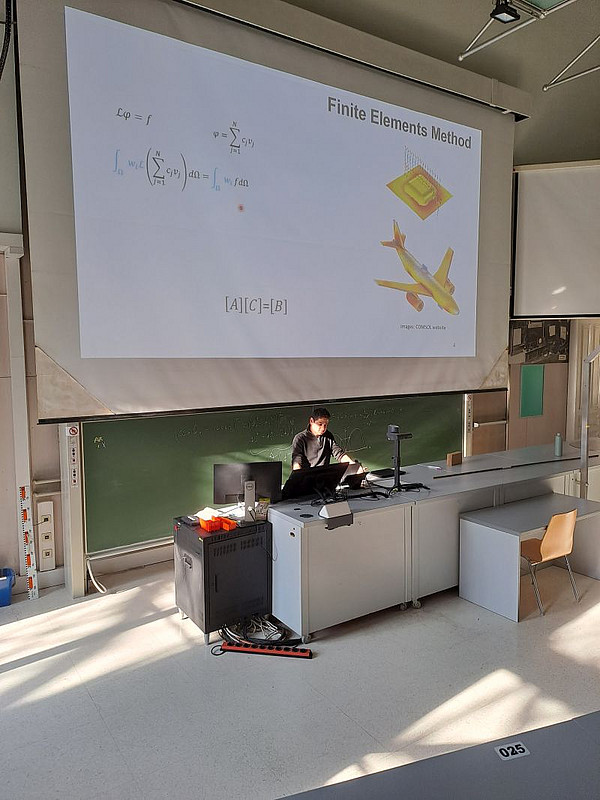
The monthly meeting of the Doctoral Academy NanoGraz for February was held on Tuesday 28. In the meeting, Ph.D. students Masoud Hamidi and Diana Shakirova introduced the audience to finite-element simulations of electromagnetics problems, with a particular focus on efficient meshing of the simulation domain for chiral structures. Afterward, Dr. Adria Canos-Valero gave an insightful and engaging presentation on rotational behavior of electromagnetic fields at the interface of two dielectric media under total internal reflection condition.
Radiochemical effects of thermal neutron capture in coordination compounds
Jan M. Welch
Center for Labelling and Isotope Production (CLIP), TRIGA Center Atominstitut, TU Wien, Vienna,
An extended tutorial-style introduction to applied radiochemistry and related concepts including nuclear (radioactive) decay and nuclear reactions and their electronic (chemical) consequences will be presented. Special emphasis will be placed on 1) differences in the scale of nuclear and electronic (chemical) processes, 2) the nature and detection/quantification of decay radiation as a radiochemical tool and 3) the application of nuclear reactions (with thermal neutrons) to the production of useful radioisotopes. The electronic (chemical) effects of nuclear reactions (thermal neutron capture) on coordination complexes of molybdenum(IV) (nitro, fluoro, methyl and unsubstituted molybdenum(IV)oxophthalocyanines; Figure below, left) and chromium(III) (Tris(2,2,6,6-tetramethyl-3,5-heptandionato)chromium(III); Figure below, right) and the application thereof to radioisotope production for medical and technical application will be discussed. Finally, a short overview of prospective work and concepts in the area will be presented.
Freitag, 03. Februar 2023, 14.00 Uhr
Hörsaal HS 10.01, Heinrichstraße 28, EG
Sidestepping Kasha's rule in 2D semiconductors - excitons with negative-mass electrons
John M. Lupton
Institute of Experimental and Applied Physics, University of Regensburg, Regensburg, Germany
Novoselov and Geim pointed out early on that exfoliated monolayers of transition metal dichalcogenides are “essentially gigantic 2D molecules” (PNAS 2005). Owing to the extraordinary oscillator strength of mobile excitons, transitions can be identified which involve electrons in high-lying conduction bands. In effect, these transitions constitute a semiconductor analogue of absorption and fluorescence from the molecular S2 state – a violation Kasha’s emblematic rule.
Electrons in high-lying conduction bands have negative effective mass, giving rise to a unique progression of vibrational quanta in the photoluminescence. Unlike in most molecules, however, excitons in semiconductor monolayers can be driven at sufficiently high powers that they are coherently controlled and give rise to quantum interference phenomena such as electromagnetically induced transparency. In monolayer WSe2, for example, these high-lying excitons are characterized by narrow bands (<2 meV width) in a spectral range far above the bandgap, and make up an effective three-level quantum system with the bandgap exciton. Under electrical gating, UV-emitting trions form, exotic quasiparticles involving electrons of both positive and negative mass which emit circularly polarized light.
The electric-field dependence opens the possibility of tuning excitonic quantum interference for potential device applications. In addition, because of the further electronic confinement effects arising in twisted bilayer structures, the oscillator strength of high-lying species can be enhanced in stacked structures, opening up further avenues for tuneable excitonic quantum optics.
Freitag, 27. Jänner 2023, 14.00 Uhr
Hörsaal HS 10.01, Heinrichstraße 28, EG
The doctoral candidates of NanoGraz started the year by visiting the Pharmaceutical Technology group of Andreas Zimmer. They were introduced to the basics of what pharmaceutical technology and nanotechnology is about and then got to experience what lab work in this field is like.
One group learned about the methods of Dynamic Light Scattering, Differential Scanning Calorimetry, and Rheometry with which pharmaceutical systems are characterized. The other group took part in the manufacturing of tablets and suppositories and even got to bring their self-made suppositories with them home.
We hope that everyone had a nice time and that it will strengthen our collaboration in the future.
A special thank goes out to Bianca Seidl, Gabriele Kolany, Katharina Puskac, and Martin Reiser for giving the tours.
Phase transitions and behavior in organic semiconductor thin films
J. Novák
Dept. of Condensed Matter Physics, Faculty of Science, Masaryk University, Kotlářská 2,
CZ-611 37, Brno, Czech Republic
The talk will deal with phase transitions and behavior of small molecule organic semiconductors (OSMs) as induced by various factors. At the beginning, I will give a short introduction to x-ray scattering techniques, which are main tools in the presented research, and physics and chemical nature of OSMs. Thereafter, individual cases of observed phase behavior will be discussed: (I) metal surface modification induced ultra-thin film phase and bulk phase orientation for para-sexiphenyl grown on Cu(110) surfaces; (II) thickness hindered β-phase nucleation and two-step phase transition observed for 5,11-bis(triethyl silylethynyl) anthradithiophene on amorphous substrates; (III) molecular mixing induced anisotropic ordering and smectic C phase appearance in pentacene-diindenorperylene binary mixture. Explanations for the observed behavior in the individual systems (I-III) will be provided based on substrate surface morphology and strain accumulation in molecular film; competition between entropy, molecules' steric properties, and anisotropic inter-molecular interactions; and competition between bulk and surface energy of molecular crystallites, respectively.
Freitag, 13. Jänner 2023, 14.00 Uhr
Hörsaal HS 10.01, Heinrichstraße 28, EG
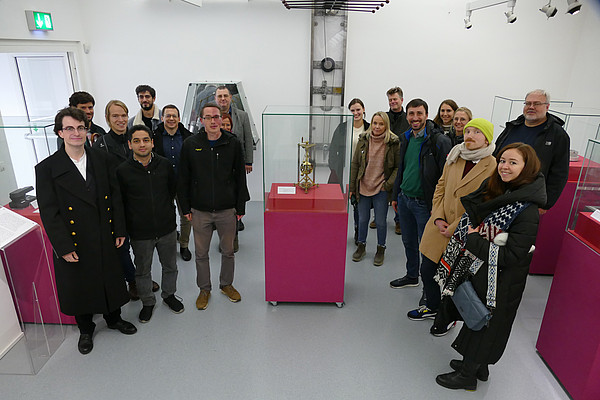
History of Physics in Graz and Excursion to the UniGraz@Museum
The November 2022 meeting of the Doctoral Academy NanoGraz featured a journey into the history of physics at the University of Graz. The global impact of historical progress achieved at the University of Graz was contextualised. Dr. Klemens Rumpf, curator of the historical physics collection at the UniGraz@Museum ( https://universitaetsmuseen.uni-graz.at/de/unsere-sammlungen-und-ausstellungen/unigrazmuseum ), illuminated in his presentation the 438 years of continuous operations in the field of physics and natural sciences. Topics ranged from the Nobel laureates who worked at the University of Graz in the field of natural science to the formulation of the Stefan–Boltzmann law. A guided tour by Dr. Rumpf through the natural science section of the UniGraz@Museum included historical experiments and physics equipment used by various well known and famous scientists. Exhibits include rare items such as a filament electrometer of Victor Franz Hess (physics Nobel prize 1936) used to measure cosmic radiation, a telescope acquired in 1885 during the professorship of Ludwig Boltzmann and the first Styrian LASER constructed by Professor Aussenegg in 1964. Reproductions of historical experiments like Chladni plates, which illustrate vibrational modes and were first published in 1787, encouraged the participants to try out historic techniques hands-on.
Acknowledgments: Special thanks to Dr. Klemens Rumpf (Institute of Physics) and Mag. Franz Stangl (UniGraz@Museum) for the support and access to the UniGraz@Museum.
Author: Thomas Boné
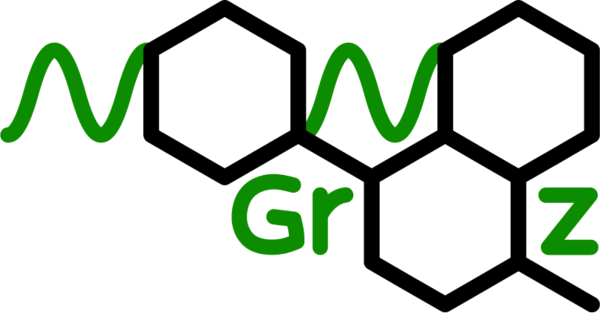
The NanoGraz monthly meetings kicked off in October with a tour of the OpNaQ group’s labs (Banzer group). NanoGraz members Johannes Bütow and Brian Kantor showcased their experimental setups while overviewing their work on structured light and its applications. With the diverse academic background of the NanoGraz members joining the meeting, a wealth of interesting topics were discussed.
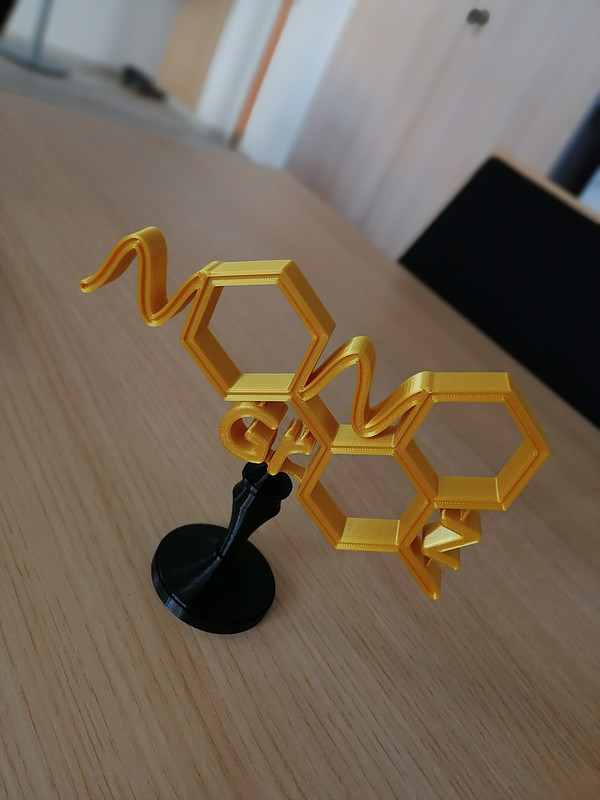
In May 2022, we started a logo design competition to create a new and unifying corporate identity for the NanoGraz doctoral academy. Several very creative designs were submitted by the NanoGraz PhD candidates. Philipp Hurdax won the award (see photo) for the best logo design. Congratulations Philipp! The new NanoGraz logo will serve as an overarching symbol for our joint and interdisciplinary activities in the framework of the doctoral academy.
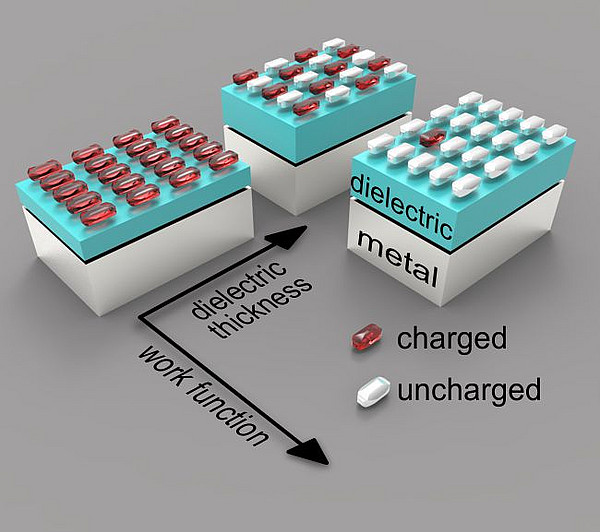
Philipp Hurdax recently finished his PhD thesis entitled “Charge Transfer Across Ultrathin Dielectric Layers: A Controlled Study of the Phenomenon on MgO on Ag(100)”. Ultrathin dielectric films on metals have come into the focus of research due to their novel properties compared to both pristine metals and bulk dielectrics. They can decouple adsorbates from the underlying metal; however, they can also promote charge transfer into adsorbates. In his thesis, Philipp provided answers and the missing understanding of the phenomenon of charge transfer across dielectric interlayers both qualitatively and quantitatively, by using a combination of surface science techniques, including angular resolved photoemission spectroscopy and photoemission orbital tomography, which were supported by scanning tunneling microscopy experiments and density functional calculations. By controlling the preparation parameters of the dielectric/metal substrate, he was able to tune the charge transfer into adsorbates and demonstrated how the different electrostatic coupling of charged and uncharged species on the surface leads to surprising phenomena and affects the behavior of the molecular films in several interesting ways.
Sprecher
Univ.-Prof. Dr. Peter Banzer
peter.banzer(at)uni-graz.at
+43 (0)316 380 - 8560
Univ.-Prof. Dr. Thomas Weiss
thomas.weiss(at)uni-graz.at
+43 (0)316 380 - 5228




